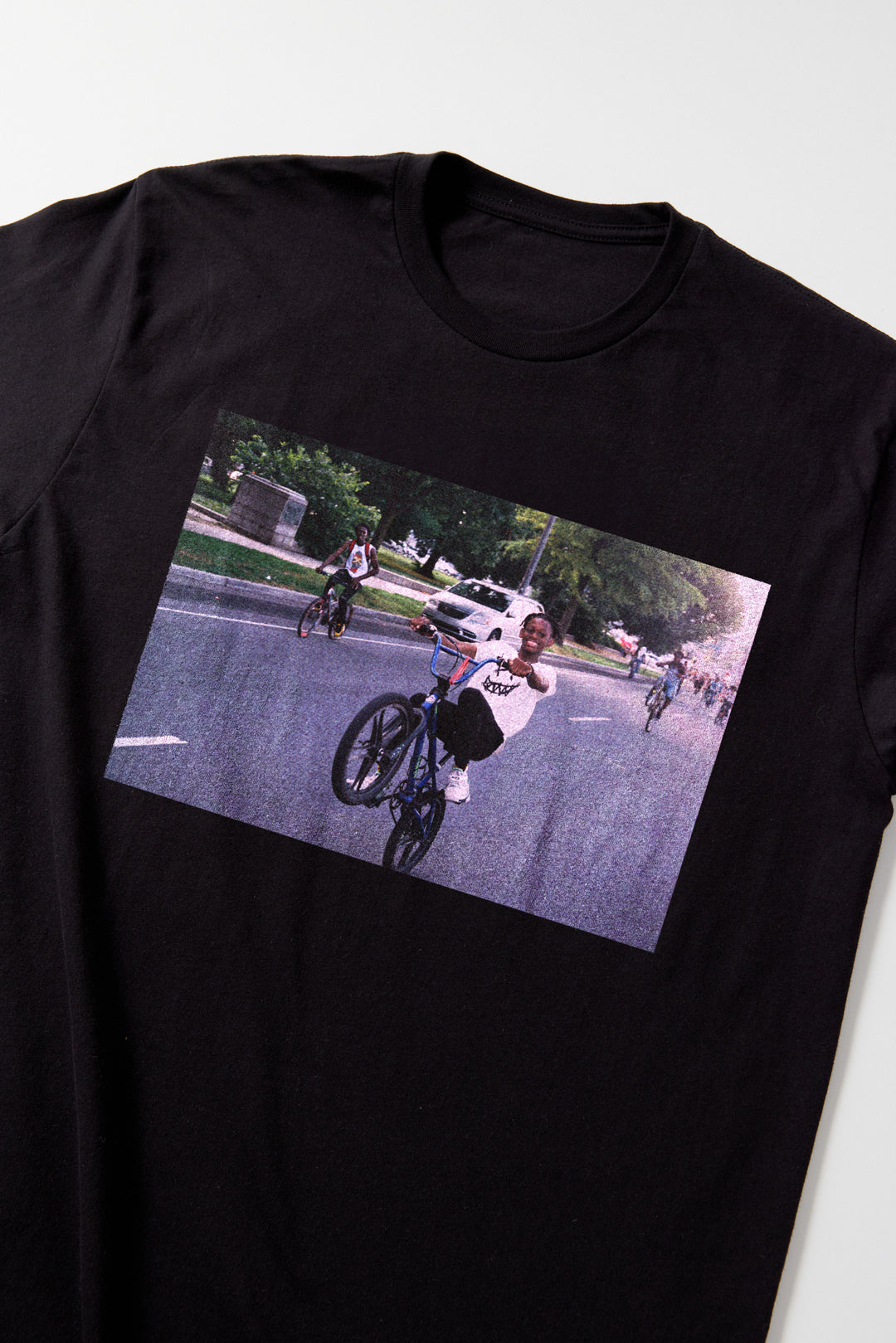Solange Knowles & the Need to Stand in Unsafe Spaces

Words By Karas Lamb @karaslamb | Photo By @saintrecords
With the arrival of the Fall ‘16 collection from Pyer Moss, designer Kerby Jean-Raymond presented a line that posed the question, “What does schizophrenia look like for a whole community?” Studded with references to pivotal moments in the Black Lives Matter movement and related grassroots efforts, the collection teased a bit of beauty from the trauma that colors the black experience without downplaying the pain -- a caul covering black bodies that garments cannot conceal or translate completely. One that exists to reiterate and enforce an informal caste, even for the black people that have beaten the odds to rise to the top of America’s food chain. Adjacent to the creature comforts of wealth and critical acclaim are always the lines you’d dare not cross or the dreams you’d dare not dream and the things you should never say, precisely because you are black.
Nearly a year after the line debuted, Solange Knowles burrows beneath the landmark moments, post-mortems and protest chants punctuating modern black life to answer the question at the core of Jean-Raymond’s collection in a personal essay published to Saint Heron. Prompted by a confrontation during a family outing with her husband and son, Knowles dissects the micro-aggressions and “business-as-usual” brushes with inhumanity that define the American experience on a daily basis for black people - a point she is uniquely qualified to speak to as a black woman raised in the south, who has resided in the north and occupied the stations of civilian and celebrity during her lifetime.
The racial epithets and rotting fruit thrown at Solange Knowles’ back for dancing at a Kraftwerk concert ballooned from an impassioned tweetstorm delivered during the band’s recent performance at the Orpheum in New Orleans, into a testimonial that blows open the collective pain and constant policing that come stock with black life. One that also makes plain, for anyone apt to get it twisted, that age, privilege, pedigree and celebrity do not provide immunity from white supremacy. More important than the translation of those fraught experiences, however, was the decision Knowles made in that moment of trauma, to keep dancing.
“You constantly see the media having a hard time contextualizing black women and men as victims every day, even when it means losing their own lives. You do not care in that moment because you understand that many of your followers will understand and have been through this same type of thing many a times, and if it means them hearing you say it’s ok, you will rise again throughout these moments, then it means something bigger to you.”
It is almost never considered rude to stand at a live concert, the one venue - opera houses and symphonies aside - where it is customary for people to move and make merry amongst friends. The ability to dance and enjoy the music should be the least of the freedoms a ticket purchase guarantees. Except that America’s rules of engagement for black people suggest that even joy should be policed in a nation where the audacity to breathe far afield of a peculiar institution, is considered our very first, most egregious and continuously punishable offense. Ahead of organized efforts to secure basic human rights or address systemic injustice, just being black and proud and present in traditionally white spaces where there are few, if any, friends, is arguably as burdensome a load to bear as discriminatory policy, state sponsored violence and all of the other more obvious inequalities visited upon marginalized populations in the U.S.
We are first instructed as children to work twice as long, twice as hard and be twice as smart as our non-black counterparts; a daily mantra in many black households that rests on the shoulders of young men and women in the same way that it burdened their grandparents before them. We are chided for using “outside voices” or being opinionated in mixed company for fear of drawing attention to ourselves. Criticized for meeting our hard fought achievements outside of sports arenas with anything more than zealous humility. Born into America’s office culture of respectability politics, black people are expected to follow this etiquette to the letter in spite of the fact that the policies of the United States have never respected them.
From classrooms to corporations and red carpets, black people are painted into corners, forced into uniforms that satisfy white ideals for the black body and sent out into the world under the strict directive, “don’t let them see you sweat.” The alternative, then, is to quietly and consistently project images of excellence and grace and dogged determination while somehow making it clear that you take no tea for the fever and have never been a shrinking violet (cue: The Old Solange. The seasoned bruiser you forgot about...from the elevator). That dual existence is not maintained without psychological damage, which is usually bookended by inherited trauma and constant physical threats that no amount of fame or wealth or career success can mitigate; a point that presently divides professional sports as San Francisco 49ers quarterback Colin Kaepernick’s protest of the national anthem gains traction across the NFL.
Kaepernick first sat, then took a knee, in order to bring attention to the extra judicial killings of black men and women by law enforcement officers across the United States. Fifteen black people have been killed by police since Kaepernick began his protest, a morbid figure that arguably justifies the stance he’s chosen to take. A stance that has also netted him death threats. Though Kaepernick made the decision to sit and Knowles was compelled to stand, criticism of our slightest movements and misinterpretation of our most sincere motives means that it really does not matter how we position our bodies if the target is never to be removed from our backs. America’s omnipresent white gaze forces black people to perform the choreography of survival without intermission. For white people concerned with policing blackness in America, the problem is not that we dance. The problem begins when we break with performing our pain and stop dancing for them.
Adding insult to injury, mainstream media outlets routinely address the protests of black Americans by banishing them to a vicious spin cycle or packaging them neatly as national conversations on race that do not get regular airtime unless precipitated by a violent death. There is little to no explanation of the repeated lack of justice in crimes committed against African-Americans or coverage comprehensive enough to engender anything other than indifference from the policy makers, law enforcement officers and talking heads responsible for upholding America’s founding principles, which are universally endearing, but sadly still sectarian in application.
There are, however, small but consistently accessible triumphs to be found in public acts of defiance. By performing dissent in public spaces and doing so often, however unsafe, black people might counter some of the damage done to the psyche by domestic acts of terror, internalized anger and all of the exhausting water cooler conversations we tolerate to ensure the world gets us. Though editorial items and open dialogue on these issues remain an integral part of navigating, documenting and surviving life as a black person, commitments to increased physical presence and public joy in spaces marked by a visible lack of diversity could ultimately prove more effective than blacksplanation at dismantling the troubling mainstream translation of the black experience, as a history of violence that we bear the sole responsibility for and are inherently contented to carry.
The reality is that most of the spaces we occupy in order to live freely within the U.S. are not truly safe for us. They never have been. Though many were built by our enslaved ancestors, it goes without saying that they were not built for us. Occupying any of them is a threat to our lives because our presence is the ever punctual elephant in the room that speaks to the imperfection of this union and challenges the bootstrap narratives of the super rich as much as it portends a long-feared reckoning - one that lurks in the shadows of our finest cities and conjures the type of boogie man that frequently finds riot police and tanks in the ghetto - over the institutions of slavery and Jim Crow and capital punishment, with or without the formality of conviction.
Black bodies signify everything America would rather forget about itself. Modern black success, measured or wild, is antithetical to the promises first made by the founders of this nation. Black people are the evidence of every era in which this country has failed at the tasks of humanity and equality and we have managed to survive them all with ingenuity and an inexplicable amount of grace. If we are to be indefinitely subjected to death as a result of the white fear or guilt we embody, it is wisest to celebrate at every juncture, in every geographic location where we've gathered. It makes sense to break with the written and unspoken rules governing our communities just to dance, because the truth is that none of us knows when we will be sentenced to die for little more. And who wants to die without having lived?
In Knowles’ actions is a mandate to be more openly allied with and unapologetic about our blackness than we have ever been. Chewing ourselves into a fine paste to satisfy American ideals or appease people irritated by our presence is a futile exercise. Black people should, instead, be compelled to stand freely. To dance and shout and sing and speak and create without fear. To win with fervor, in order to ensure that the images available to black babies and major media platforms are overwhelmingly those of us divesting from the dominant narrative that says our inheritance is little more than Transatlantic sediment and our protest is only acceptable within the confines of pacifism or explicit permission from the powers that be.
The images we seek to convey should be those in which we break with the dominant directives of obedience and patience that we have been sold in exchange for the perceived comforts people of color have never enjoyed in numbers. The messages we send should challenge those that visit disrespect upon us, and in the tradition of Black Twitter, they should be unrelenting. These displays of dissent should occur early and often and never fail to speak to our resilience and impenetrable joy, wherever we are in the world, whatever our respective tax brackets, our languages or gods or goodness or kink. By divesting from constant explanation of ourselves as a value proposition, we systematically wrest ownership of our bodies and communities and lived experiences from those committed to our extinction and are further empowered to invest in performing joy in ways that edify our humanity, history and presence; black people have been here, we will continue to be here and we will never be broken. Keep bouncing.
|
Karas Lamb is a writer and fledgling techie working between Philadelphia, PA and New York City. Concerned with the intersection of arts and activism, Karas is committed to the study of black music and its role in American socio-political movements and popular culture. She might be your favorite rapper's favorite writer. |

